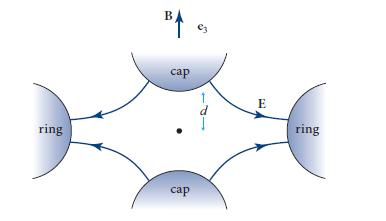A clever technique for studying the behavior of individual electrons or ions is to entrap them using
Question:
A clever technique for studying the behavior of individual electrons or ions is to entrap them using a combination of electric and magnetic fields. One of the simplest and most useful devices is the Penning trap. Basically this comprises a uniform magnetic field B combined with a hyperboloidal electrostatic field that is maintained between hyperboloidal electrodes as shown in Fig. 20.7. The electrostatic potential has the form Φ(x) = Φ0(z2 − x2/2 − y2/2)/(2d2), where Φ0 is the potential difference maintained across the electrodes, and d is the minimum axial distance from the origin to the hyperboloidal cap (as well as being 1/√2 times the minimum radius of the ring electrode).
(a) Show that the potential satisfies Laplace’s equation, as it must.
(b) Now consider an individual charged particle in the trap. Show that three separate oscillations can be excited:
(i) Cyclotron orbits in the magnetic field with angular frequency ωc,
(ii) “Magnetron” orbits produced by E × B drift around the axis of symmetry with angular frequency ωm.
(iii) Axial oscillations parallel to the magnetic field with angular frequency ωz.
Assume that ωm ≪ ωz ≪ ωc, and show that ωz2 ≈ 2ωmωc.
(c) Typically, the potential difference across the electrodes is ∼10 V, the magnetic field strength is B ∼ 6T, and the radius of the ring and the height of the caps above the center of the traps are∼3 mm. Estimate the three independent angular frequencies for electrons and ions, verifying the ordering ωm ≪ ωz ≪ ωc. Also estimate the maximum velocities associated with each of these oscillations if the particle is to be retained in the trap.
(d) Solve the classical equation of motion exactly, and demonstrate that the magnetron motion is formally unstable.
Figure 20.7.

Step by Step Answer:

Modern Classical Physics Optics Fluids Plasmas Elasticity Relativity And Statistical Physics
ISBN: 9780691159027
1st Edition
Authors: Kip S. Thorne, Roger D. Blandford





